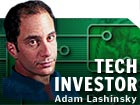|
Amazon, you're no Wal-Mart
|
 |
January 22, 2002: 5:35 p.m. ET
Jeff Bezos has always wanted his company to be thought of as the next Wal-Mart -- but he's got a long way to go.
BY Adam Lashinsky
|
SAN FRANCISCO (CNN/Money) - "There are two types of retailers," Amazon.com CEO Jeff Bezos proudly proclaimed in a press release Tuesday morning: Those that try to get the highest prices from their customers and those that charge the lowest prices possible all the time -- that's the kind Amazon wants to be.
There are indeed two types of retailers -- only I make the cut at those that make money consistently and those who don't. The undisputed leader of the first category (and, not coincidentally, the king of the strategy Bezos now emulates) is Wal-Mart.
Amazon has long wanted to be thought of as the next Wal-Mart. So it's interesting, on the day Amazon first reported a quarterly profit the way real companies do (that is, according to Generally Accepted Accounting Practices, or GAAP -- no pro forma gobbledygook) to examine just how far away Amazon is from being in the same camp as Wal-Mart.
First, though, credit where it's due. That Amazon eked out a fourth-quarter profit of a penny per share, or $5 million, on sales of $1.1 billion, is truly an accomplishment. Accordingly, investors bid up Amazon's shares amid a horrid overall tape. Its shares skyrocketed more than 25 percent, to $12.77.
Dig deeper
But dig just a little under the surface to see the work that's left for Amazon to do. Buried in the pile of data in its fourth-quarter earnings release is the key point that Amazon's operating profit margin is just 1.3 percent. Gross margins are an impressive 25 percent, but Amazon still spends so much on fulfillment of orders, marketing and paying its staff that there's little left for shareholders.
Its cash position dwindled by $100 million over the year, to just under $1 billion. And it has $2.2 billion in long-term debt, about $30 million more than it had a year ago. That's a meaningful number to worry about. For all of 2001, Amazon paid $139 million in interest expense. That means that for every dollar of sales, Amazon pays four cents to holders of its debt.
Contrast this with Wal-Mart, which reported its fiscal third-quarter earnings in November for the period ending Oct. 31, arguably a horrible quarter for even the best business. The gross margin was 21 percent, but Wal-Mart had a 2.8 percent net profit margin on sales of $52.7 billion. That's after paying taxes of $872 million, or 1.7 percent of sales. (You won't find the expression "income taxes" in Amazon's release -- it has so many losses from previous years that it doesn't yet pay out to about Uncle Sam.)
Wal-Mart also is loaded with long-term debt, to the tune of $15.8 billion. But its quarterly payments amount to less than one-half of one percent of sales. And the operating margin for its Wal-Mart Stores segment is an impressive 7 percent.
Amazon and Wal-Mart each turned in 15 percent-plus year-over-year revenue gains. Amazon is worth about 1.1 times annualized sales (generously annualizing based on fourth-quarter sales). Wal-Mart, far more profitable, is worth about 1.2 times its annual sales based on the third quarter alone. In other words, Amazon already is being rewarded for reaching Wal-Mart's level.
Congratulations Amazon.com, you've come a long way. But you've got a long, long way to go.
Sign up to receive the Tech Investor column by e-mail.
Plus, see more tech commentary from David Futrelle and Adam Lashinsky, and get the latest tech news. 
|
|
|
|
|
|

|

